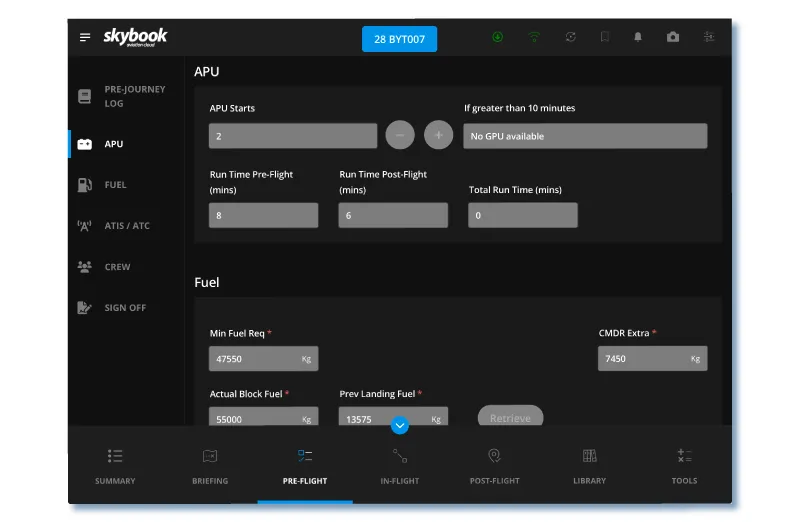By Dan Cook |
02 May 2025
SHARE
APU Start Data on EFB
Let’s talk APU starts…
In this article, we explore how logging APU start data in your EFB phases of flight, can drive smarter decisions, reduce fuel burn, and streamline maintenance.
What is an APU Start?
An APU (Auxiliary Power Unit) start refers to the process of starting the small turbine engine, usually located in the tail section of an aircraft.
The APU provides:
- Electrical power for cockpit instruments, avionics, lighting, and cabin systems when the main engines are off.
- Pneumatic pressure for air conditioning and engine start.
- Backup power in the event of an in-flight generator failure.
The APU is typically started before engine start-up and may be turned off after take-off, once the engines take over power generation.
However, it can also be left running in-flight for redundancy, depending on airline procedures.
How is APU usage managed across different airlines?
Fuel cost management
- APUs burn fuel, so many airlines try to minimise usage to save money.
- They often encourage switching to ground power (GPU) as soon as possible at the gate.
Environmental policies
- APUs emit CO₂ and noise, so airlines aiming for sustainability will limit APU time.
- Some use APU timers or automatic shut-offs after arrival.
- Airports may restrict APU use to reduce emissions.
Standard operating procedures (SOPs)
- Each airline’s Flight Ops Manual will have clear guidelines. When APU can be used, who can authorize extended use and when to switch between APU and external power
- Some airlines have strict SOPs, such as "No APU use unless GPU is unavailable."
Fleet differences
- Some aircraft are equipped with newer APUs that are quieter/more efficient (like those on the A350 or 787).
- Airlines may standardize APU procedures based on aircraft type.
Different aircraft have unique APU configurations and operating procedures:
- Boeing 737 & Airbus A320
APU primarily used for ground power, engine start, and air conditioning before departure. Typically shut down before taxiing.
- Regional Jets (E.g. Embraer E-Jets, CRJ Series)
May use the APU throughout taxiing due to smaller onboard power sources.
- Long-Haul Aircraft (E.g. Boeing 777, Airbus A350, A380)
APU can be used in-flight for redundancy, particularly on ETOPS (Extended-range Twin-engine Operations) routes.
Airline Examples
- Lufthansa
Strong focus on limiting APU time at major hubs.
- Delta
Incentivises ground power use through internal tracking.
- Ryanair
Very strict on APU time to keep costs low.
- Middle Eastern airlines (e.g. Emirates)
May allow more APU use due to high temps and fewer GPU options at outstations.

APU Data on EFB apps for flight operations
Recording APU usage in an Electronic Flight Bag (EFB) provides multiple operational benefits:
Fuel Monitoring & Cost Control
- APUs consume fuel, so tracking APU run-time helps optimize fuel efficiency and reduce unnecessary usage.
- Dispatchers and pilots can compare planned vs. actual APU fuel burn to refine airline policies.
Maintenance & Reliability
- Logging APU starts, shutdowns, and faults in the EFB helps maintenance teams track wear and potential failures.
- Automated alerts can notify engineers of excessive or abnormal APU operation.
Regulatory & Compliance Reporting
- Airlines operating under strict ETOPS regulations may need to document APU availability for safety compliance.
- EFB synced data to the ground for complete flight history data ensures accurate record-keeping for audits and inspections.
Real-Time Decision-Making
- Pilots can review APU status before flights, ensuring a reliable power source in case of ground power unit (GPU) unavailability.
- Dispatchers can adjust flight planning based on APU limitations, weather conditions, or operational constraints.
Efficiency in Ground Operations
- Airlines can analyse APU usage trends to determine if reliance on GPUs can reduce fuel burn and environmental impact.
- Helps optimise turnaround times by ensuring APU is started and shut down at the most efficient moments.
Utilising APU data in aviation
Understanding APU starts is essential for pilots, dispatchers, and maintenance teams to ensure smooth operations, fuel efficiency, and compliance with safety regulations.
By utilising the flight crews journey log data on the skybook EFB application; airlines gain real-time visibility into APU usage.
Allowing for smarter fuel management, streamlined maintenance, and better decision-making across flight operations.
Curious how skybook helps airlines unlock smarter insights with all your EFB and dispatch data in one place? Be sure to get in touch!
By Dan Cook |
02 May 2025
SHARE

